Telescopes:
Angular Resolution and
"Seeing"
Telescopes are designed to focus light into an image, or picture. The
clearer the image, the more information can be learned from it. In
general, three things control the clarity of a telescope's images:
aperture size,
quality of construction, and the
observing site.
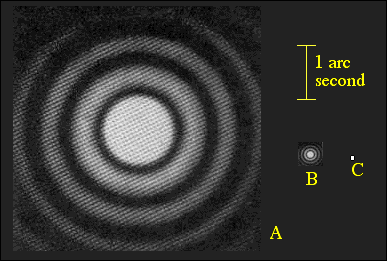 1)
Aperture size refers to the diameter of the mirror or lens
used to focus the light. Any lens or mirror distorts the light from a
distant star (which appears as a point of light because it is so
distant) into a series of concentric rings called a diffraction
pattern. The larger the telescope aperture, the smaller the pattern.
The picture at right shows the diffraction patterns produced by
telescopes with (A) a10-cm (4-inch) diameter mirror,
(B) a 1.0-meter (40-inch) mirror, and (C) a 10-meter
(33-foot) mirror. Smaller patterns mean a star's light is
concentrated into a smaller area on a photograph, resulting in a
clearer picture. This is one of the reasons astronomers usually
prefer to use large telescopes.
1)
Aperture size refers to the diameter of the mirror or lens
used to focus the light. Any lens or mirror distorts the light from a
distant star (which appears as a point of light because it is so
distant) into a series of concentric rings called a diffraction
pattern. The larger the telescope aperture, the smaller the pattern.
The picture at right shows the diffraction patterns produced by
telescopes with (A) a10-cm (4-inch) diameter mirror,
(B) a 1.0-meter (40-inch) mirror, and (C) a 10-meter
(33-foot) mirror. Smaller patterns mean a star's light is
concentrated into a smaller area on a photograph, resulting in a
clearer picture. This is one of the reasons astronomers usually
prefer to use large telescopes.
2) Quality of
construction usually means how carefully the mirrors
and/or lenses in the telescope were made. A mirror has an ideal shape
(generally a "paraboloid" or 3-D parabola) to which the opticians try
to grind the lens or mirror. The closer the optician comes to
achieving this perfect shape, the better the images the telescope
will produce. Usually, the optician has to invest more time and
effort in making a better quality lens or mirror, so it costs more.
Thus, there is a tradeoff to be reached between mirror quality and
mirror cost. In recent years, telescope opticians have developed some
strategies that help them make large, high quality mirrors at lower
cost (for example, spin-casting
and active
optics).
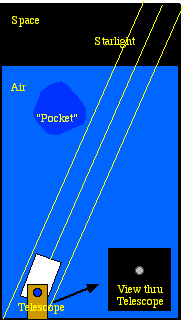 3)
The observing site -- where the telescope is located -- is
perhaps the most critical thing controlling a telescope's image
quality. Imagine a beam of light coming from a distant star. It may
have traveled for millions of years, but in the last fraction of a
second before this light reaches your telescope, it encounters the
earth's atmosphere. Even if the sky is free of clouds, the light
encounters pockets of warmer or cooler air, and pockets of drier or
moister air. These pockets act like lenses and bend (or "refract")
the light very slightly, changing the angle at which the beam of
starlight hits your telescope mirror. As the wind blows the pockets
of air along, the angle at which the beam hits your telescope
changes, causing the image of the star to flicker
and move around. If you are taking a photograph of the star, the
moving image builds up into a large, fuzzy image of the star, as
shown at right.
3)
The observing site -- where the telescope is located -- is
perhaps the most critical thing controlling a telescope's image
quality. Imagine a beam of light coming from a distant star. It may
have traveled for millions of years, but in the last fraction of a
second before this light reaches your telescope, it encounters the
earth's atmosphere. Even if the sky is free of clouds, the light
encounters pockets of warmer or cooler air, and pockets of drier or
moister air. These pockets act like lenses and bend (or "refract")
the light very slightly, changing the angle at which the beam of
starlight hits your telescope mirror. As the wind blows the pockets
of air along, the angle at which the beam hits your telescope
changes, causing the image of the star to flicker
and move around. If you are taking a photograph of the star, the
moving image builds up into a large, fuzzy image of the star, as
shown at right.
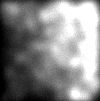 At
sites near sea-level, like Bowling
Green, Ohio, the light must pass through the full depth of
earth's atmosphere. It is likely to encounter many pockets of
warm/cool and dry/moist air, and thus be severely blurred. Click on
the image at right to see a picture of the inner part of the globular
cluster M5. The image shows a region 80 arcseconds on a side. The
stars appear blurry and very large in diameter (about 3 arcsec
across, typical of what we see in B.G.). Many stars appear merged
together. It is difficult to count how many stars are present, and to
measure the amount of light associated with each star (its apparent
brightness). An astronomer might not be able to obtain much useful
information about the cluster from this picture.
At
sites near sea-level, like Bowling
Green, Ohio, the light must pass through the full depth of
earth's atmosphere. It is likely to encounter many pockets of
warm/cool and dry/moist air, and thus be severely blurred. Click on
the image at right to see a picture of the inner part of the globular
cluster M5. The image shows a region 80 arcseconds on a side. The
stars appear blurry and very large in diameter (about 3 arcsec
across, typical of what we see in B.G.). Many stars appear merged
together. It is difficult to count how many stars are present, and to
measure the amount of light associated with each star (its apparent
brightness). An astronomer might not be able to obtain much useful
information about the cluster from this picture.
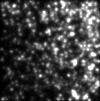 About
a century ago, astronomers learned that mountain tops afforded a
clearer view of the stars -- not because the telescope is closer to
the stars, but because it is above more of the earth's atmosphere.
There are fewer warm/cool or dry/moist air pockets to look through,
so the beam of starlight is bent less. The image through your
telescope moves less, resulting in clearer photographs. The image at
left shows the same region of M5 as seen from a top-quality mountain
site like Mauna
Kea, Hawaii. The star images appear crisper and smaller in
diameter (only about 0.5 arcsec across). An astronomer can count the
number of stars more accurately and make more accurate measurements
of the brightness of each individual star.
About
a century ago, astronomers learned that mountain tops afforded a
clearer view of the stars -- not because the telescope is closer to
the stars, but because it is above more of the earth's atmosphere.
There are fewer warm/cool or dry/moist air pockets to look through,
so the beam of starlight is bent less. The image through your
telescope moves less, resulting in clearer photographs. The image at
left shows the same region of M5 as seen from a top-quality mountain
site like Mauna
Kea, Hawaii. The star images appear crisper and smaller in
diameter (only about 0.5 arcsec across). An astronomer can count the
number of stars more accurately and make more accurate measurements
of the brightness of each individual star.
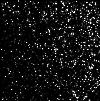 The
higher up in the atmosphere you are, the fewer air pockets there are
above you to blur your view of the stars. Astronomers have hung
telescopes from balloons and flown them in rockets, but the best
long-term solution is to place a telescope on a satellite in earth
orbit. Currently, the Hubble
Space Telescope is the "diva" of space telescopes. Its
2.4-meter diameter aperture provides a small diffraction pattern (see
Item 1), and though its main mirror was
originally ground incorrectly, it has been fitted with corrective
optics (essentially fancy "eyeglasses") which make it one of the
highest quality optical telescopes available (see Item
2). Because it is in space, the earth's atmosphere does not blur
or distort its images at all. The image at right shows the same
region of M5 as seen from the HST. Now the star images are
super-crisp and very small (0.1 arcsec in diameter).
The
higher up in the atmosphere you are, the fewer air pockets there are
above you to blur your view of the stars. Astronomers have hung
telescopes from balloons and flown them in rockets, but the best
long-term solution is to place a telescope on a satellite in earth
orbit. Currently, the Hubble
Space Telescope is the "diva" of space telescopes. Its
2.4-meter diameter aperture provides a small diffraction pattern (see
Item 1), and though its main mirror was
originally ground incorrectly, it has been fitted with corrective
optics (essentially fancy "eyeglasses") which make it one of the
highest quality optical telescopes available (see Item
2). Because it is in space, the earth's atmosphere does not blur
or distort its images at all. The image at right shows the same
region of M5 as seen from the HST. Now the star images are
super-crisp and very small (0.1 arcsec in diameter).
The looping movie below enables you to compare the images obtained
at the three sites directly. If you were an astronomer, which would
you rather use? It is not hard to understand why the HST is
one of the most sought-after astronomical telescopes in the world
today. Nor is it hard to understand why astronomers are looking
forward to the launch of an even larger Next
Generation Space Telescope in 2009.
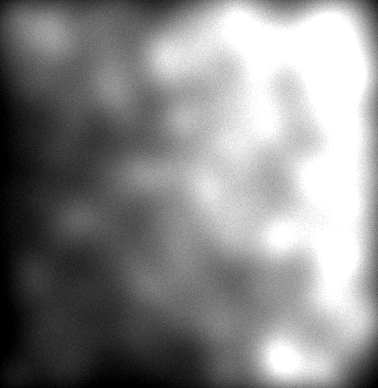
Other advantages of a space telescope include, (1) it is never
cloudy, (2) it is not affected by "light pollution" -- the glow of
city lights that brightens the sky and "washes out" many faint
astronomical objects, and (3) it can see ultraviolet and infrared
light that are blocked by the earth's atmosphere. Disadvantages
include the much higher cost compared to ground-based telescopes and
the difficulty in fixing the telescope if something breaks.
Andrew Layden
& Neil Beery
Bowling Green State Univ., Nov. 2002.
 1)
Aperture size refers to the diameter of the mirror or lens
used to focus the light. Any lens or mirror distorts the light from a
distant star (which appears as a point of light because it is so
distant) into a series of concentric rings called a diffraction
pattern. The larger the telescope aperture, the smaller the pattern.
The picture at right shows the diffraction patterns produced by
telescopes with (A) a10-cm (4-inch) diameter mirror,
(B) a 1.0-meter (40-inch) mirror, and (C) a 10-meter
(33-foot) mirror. Smaller patterns mean a star's light is
concentrated into a smaller area on a photograph, resulting in a
clearer picture. This is one of the reasons astronomers usually
prefer to use large telescopes.
1)
Aperture size refers to the diameter of the mirror or lens
used to focus the light. Any lens or mirror distorts the light from a
distant star (which appears as a point of light because it is so
distant) into a series of concentric rings called a diffraction
pattern. The larger the telescope aperture, the smaller the pattern.
The picture at right shows the diffraction patterns produced by
telescopes with (A) a10-cm (4-inch) diameter mirror,
(B) a 1.0-meter (40-inch) mirror, and (C) a 10-meter
(33-foot) mirror. Smaller patterns mean a star's light is
concentrated into a smaller area on a photograph, resulting in a
clearer picture. This is one of the reasons astronomers usually
prefer to use large telescopes. 3)
The observing site -- where the telescope is located -- is
perhaps the most critical thing controlling a telescope's image
quality. Imagine a beam of light coming from a distant star. It may
have traveled for millions of years, but in the last fraction of a
second before this light reaches your telescope, it encounters the
earth's atmosphere. Even if the sky is free of clouds, the light
encounters pockets of warmer or cooler air, and pockets of drier or
moister air. These pockets act like lenses and bend (or "refract")
the light very slightly, changing the angle at which the beam of
starlight hits your telescope mirror. As the wind blows the pockets
of air along, the angle at which the beam hits your telescope
changes, causing the image of the star to
3)
The observing site -- where the telescope is located -- is
perhaps the most critical thing controlling a telescope's image
quality. Imagine a beam of light coming from a distant star. It may
have traveled for millions of years, but in the last fraction of a
second before this light reaches your telescope, it encounters the
earth's atmosphere. Even if the sky is free of clouds, the light
encounters pockets of warmer or cooler air, and pockets of drier or
moister air. These pockets act like lenses and bend (or "refract")
the light very slightly, changing the angle at which the beam of
starlight hits your telescope mirror. As the wind blows the pockets
of air along, the angle at which the beam hits your telescope
changes, causing the image of the star to 


